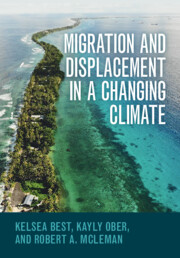Introduction
Scholars in many disciplines pursue migration research from a variety of perspectives, each discipline bringing with it a range of favorite theoretical and methodological tools (Brettell and Hollifeld 2007). No grand unifying theory exists that explains human migration behavior in all its aspects, and there are no signs that one is soon to be developed. There is, however, great complementarity in the various ways scholars have sought to explain migration, each such method making its own useful contribution to a broader understanding. In exploring migration in the context of human adaptation to climate, it is useful to first review important explanatory concepts from across disciplines and describe how these can help clarify human migration behavior more generally.
The migration process can occur across a range of spatial and temporal scales, and involve many potential actors, institutions, and systems. From the perspective of an individual migrant, the process spans the period from when he or she first contemplates the possibility of moving, through the decision-making process, the act of moving, and on into the period of adjustment at the destination. For some migrants, the process may eventually include a return to the place of origin, or lead to becoming a member of a translocal or transnational community that maintains connections and perpetuates migration between the sending and the receiving area. For migrants who travel short distances and remain within their same cultural community, the migration process may be relatively uncomplicated. For migrants travelling long distances to settle in new and unfamiliar places, migration may be a long and arduous process, with integration into the destination population never completed within the migrant’s own lifetime, but continued by subsequent generations.
